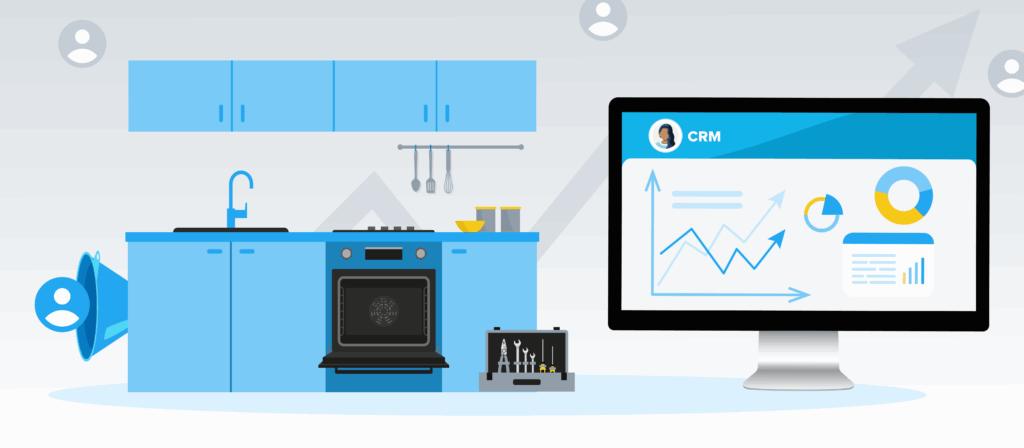How to acquire kitchen remodeling leads online

In the home improvement industry, kitchen remodels are one of the most lucrative—and competitive—markets. Whether you specialize in cabinets, countertops, or full kitchen transformations, success depends on a steady flow of kitchen remodeling leads. But with consumer behavior shifting online, how you acquire those leads matters as much as the quality of your work.
In this guide, we’ll break down the two main strategies to fill your pipeline—generating vs. buying kitchen remodeling leads—and explain how to make both approaches work together. You’ll also learn proven tips and compliance best practices to ensure your investment drives real, sustainable growth.
Generate vs. buy kitchen remodeling leads: What’s the difference?
When it comes to lead acquisition, there are two main paths you can take: Generating your own leads for kitchen remodeling or buying them from a third party. Both have advantages depending on your goals, budget, and resources.
Generating your own leads
First-party lead generation means building and managing your own marketing funnel. You attract prospects directly through your website, ads, or content—and every lead you capture is yours.
Pros:
- Higher intent: These leads come directly from your own campaigns, meaning they’ve interacted with your brand before converting.
- Better control: You decide the ad creative, targeting, and messaging, giving you full visibility into how leads are acquired.
- Brand equity: Every ad, landing page, or email touchpoint reinforces your company’s reputation and builds long-term trust.
Cons:
- Time and cost: Building a reliable pipeline requires consistent effort, testing, and ad spend.
- Scaling challenges: Without automation and optimization, increasing volume can strain your internal resources.
Buying kitchen remodeling leads
When you buy kitchen remodeling leads, you’re purchasing consumer inquiries collected by third-party publishers, affiliate networks, or aggregators. These providers specialize in driving traffic through paid ads, comparison sites, and home improvement marketplaces—then selling those leads to remodelers like you.
Pros:
- Speed: You can start receiving leads almost immediately, instead of waiting for SEO or paid ads to mature.
- Predictable volume: Most lead providers allow you to set filters (like zip codes or project types) and scale volume based on your capacity.
- Flexibility: It’s easy to test new markets or campaigns without large upfront investments.
Cons:
- Varying quality: Not all providers are equal; some sell shared leads or outdated data.
- Compliance risk: If consent isn’t properly documented, you could face regulatory penalties for unwanted outreach.
- Less control: Since the leads originate outside your ecosystem, you rely on the provider’s process for accuracy and compliance.
In practice, most successful remodeling businesses use a hybrid model—they generate leads through their own marketing while supplementing volume by buying from trusted partners.
How to generate kitchen remodeling leads
Building your own lead generation system gives you full ownership and long-term scalability. Here are several proven tactics to attract homeowners actively researching kitchen renovations.
1. Optimize your website for conversions
Your website should serve as your 24/7 sales engine. Start by ensuring your homepage and service pages clearly communicate your value, display real project photos, and feature strong calls to action—like “Request a Free Quote” or “Get a Design Consultation.”
Add a simple, mobile-friendly form that collects key info: Project type, location, timeline, and budget. If possible, integrate chat or scheduling tools for instant responses.
2. Leverage local SEO
Since most kitchen remodels are locally driven, optimizing for local search is critical. Make sure your Google Business Profile is fully filled out with photos, service areas, and recent reviews.
Focus on keywords like “kitchen remodeling contractors near me” and “best kitchen remodeling companies in [city].” Publish blog posts about remodeling trends or before-and-after projects to improve rankings and visibility.
3. Run paid ads on Google and social media
Paid search and social campaigns can quickly drive targeted traffic. Google Ads let you reach high-intent users searching for remodeling services, while Facebook and Instagram can target homeowners based on demographics, interests, and behaviors.
For best results, drive traffic to dedicated landing pages optimized for conversions or—even better—keep them on the ad platform with Lead Ads to help reduce friction.
4. Offer lead magnets and promotions
Incentivize homeowners to share their information by offering free design consultations, downloadable kitchen planning guides, or promotional discounts. Use these lead magnets to collect contact info and follow up with tailored offers.
5. Nurture leads with email automation
Not every homeowner is ready to start immediately. Use automated email sequences to stay in touch with cold leads, share project inspiration, and remind them why your company is the best choice when they’re ready to move forward.
How to buy kitchen remodeling leads: 5 best practices
Buying leads can be an excellent way to keep your sales team busy—if you do it correctly. The key is to partner with the best kitchen remodeling leads company and put systems in place to filter and verify every lead before it reaches your reps.
Here are five best practices to follow.
1. Choose trusted partners
Look for vendors that specialize in home improvement or kitchen remodeling leads, have a reputation for compliance, and offer transparency into how their leads are generated.
Ask questions like:
- Are the leads real-time or aged?
- Are they exclusive or shared?
- Can I see the form or ad the consumer submitted?
A reputable provider will gladly show you these details.
2. Verify consumer consent with TrustedForm
Compliance should be your top priority when buying leads. If a homeowner claims they didn’t consent to be contacted, your business could face penalties of up to $1,500 per call or text under the Telephone Consumer Protection Act (TCPA).
That’s why it’s essential to use TrustedForm—the industry standard for documenting independent proof of consumer consent.
Here’s how it works:
- For each lead submitting a form, a TrustedForm Certificate is issued that captures the exact moment and webpage where the consumer opted in.
- You can replay the session to verify disclosure language and check compliance.
- Certificates are tamper-evident and can be used in case disputes arise.
By implementing TrustedForm, you help protect your business from TCPA risk while building trust with your customers.
3. Scrub and filter leads with LeadConduit
Even the best leads need validation. LeadConduit helps you automatically filter, verify, and route leads before they hit your CRM or sales team.
With LeadConduit, you can:
- Validate contact info: Confirm that phone numbers and emails are real and active.
- Scrub litigators and DNC contacts: Automatically block high-risk records that could lead to compliance issues.
- Remove duplicates: Ensure you’re not paying twice for the same homeowner.
- Enrich and route leads: Add missing data points and send them to the right rep instantly.
This process ensures your sales team spends time only on high-quality, compliant leads—saving money and improving conversion rates.
4. Track ROI and performance
Don’t just buy leads—measure their value. Tag each source and monitor how many leads convert into appointments, quotes, and closed sales. Over time, this data helps you identify which providers deliver the best kitchen remodeling leads and which campaigns need adjustment.
Use cost-per-acquisition (CPA) and return on ad spend (ROAS) metrics to guide budget decisions. Remember: a $75 exclusive lead that converts is more profitable than ten $10 leads that never answer.
5. Build feedback loops with vendors
Share your lead outcomes—like appointment rates and closed deals—with your lead providers. This feedback helps them refine targeting, improve quality, and align better with your ideal customer profile.
Vendors that value transparency will use your data to continuously optimize lead generation, benefiting both sides.
The bottom line: Smarter systems, better leads
Whether you generate or buy kitchen remodeling leads, success depends on three things: Quality, compliance, and optimization.
When generating your own leads, focus on building a frictionless digital journey—clear messaging, fast load times, and simple conversion paths. When buying leads, use TrustedForm to document consent and LeadConduit to filter and validate in real time.
By combining both approaches and using the right tools, you’ll create a predictable, scalable system for filling your pipeline with qualified, conversion-ready homeowners.



